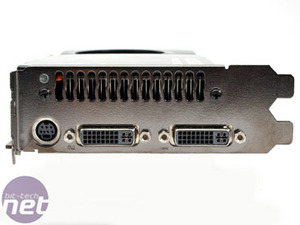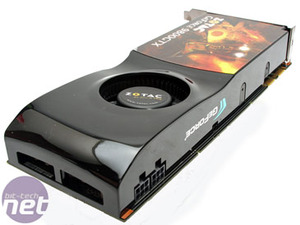Nvidia GeForce 9800 GTX reference design
Core Clock: 675MHzShader Clock: 1,688MHz
Memory Clock: 2,200MHz (effective)
Before we get onto the partner cards themselves, we should have a look at the overall reference design. All of the partner cards we have been sent so far follow this design almost to the letter, with only artwork changing on these early cards.
The design takes Nvidia’s more consumer-friendly design one step further from the GeForce 8800 GTS 512, although it is not quite as enclosed as the recently-released GeForce 9800 GX2. I have mixed feelings about the design direction, but if it helps to make the products more appealing to more consumers, that’s a good thing for PC gaming.
The front of the card is covered completely with a shiny black plastic shroud and features a single radial fan located above some of the card’s PWM circuitry.
Nvidia has shaped the shroud to improve clearance around the fan to deliver optimal cooling and airflow – this was something that was a problem with the GeForce 8800 Ultra and GeForce 8800 GTX for example, especially when three were run together in close proximity for 3-way SLI. The good thing is that this design has meant that the fan can spin slowly and like just about every dual-slot design we’ve seen from Nvidia in recent times, the fan is quiet both when gaming and when sitting idle on the Windows desktop.
Meanwhile, the back of the PCB is left bare – in the top corner next to the PCI bracket, you can see the two SLI connectors, which enables support for 3-way SLI technology on this card. Given the price, it’s quite possible that this 3-way SLI implementation will make more sense than, say, three GeForce 8800 Ultras.
Along the top edge, there is the now ubiquitous GeForce logo, along with two six-pin PCI-Express power adapters and a S/PDIF connector. Both PCI-Express power adapters need to be connected for the card to operate, as its maximum board power is quoted at 156W—that’s above the maximum combined power draw for a single PCI-Express power connector and the PCI-Express interconnect.
There are two black-coloured dual-link DVI-I connectors on the card’s PCI bracket, enabling connection to two digital or analogue (via partner-supplied DVI-to-VGA converters) displays with resolutions of up to 2560x1600. The board features the required HDCP crypto-ROM keys for both ports to simultaneously output HD video streams.
Using a DVI-to-HDMI converter, the GeForce 9800 GTX supports HDMI and, because there is an S/PDIF connection available, you can carry audio over the DVI connection. This solution isn’t quite as elegant as AMD’s current solution on its Radeon HD 2000- and Radeon HD 3000-series graphics cards, but it’s good to see that S/PDIF capabilities are going to be a standardised feature on the GeForce 9-series cards. What has been disappointing so far though is that not all of the partners are including both the S/PDIF connector and the DVI-to-HDMI converter in their GeForce 9-series card bundles – we hope to see this change going forwards though, as it’s a feature that’s going to become more and more important over time.

MSI MPG Velox 100R Chassis Review
October 14 2021 | 15:04














Want to comment? Please log in.